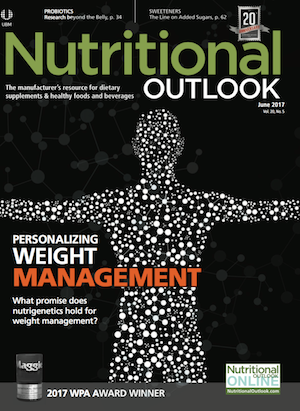Added-Sugar Solutions
Added sugars are in the crosshairs of FDA’s revised Nutrition Facts label. Here’s how companies are cutting the sugar.
Photo © Shutterstock.com/Oleksandra Naumenko

Consumers already know that everything from baked goods and barbecue sauce to dressings, desserts, and deli meats can be sugar delivery vehicles in disguise. What they may not know, however, is that some of their favorite functional foods and beverages-products designed expressly to be “good for you”-may be packed with plentiful added sugars, too.
Yet if consumers have been enjoying their protein bars, energy beverages, and even their chewable vitamin gummies in a sort of ignorant-of-the-added-sugars bliss all this time, the scales may fall from their eyes once FDA’s new “added sugars” line starts appearing on Nutrition Facts panels.
When it does, fans of functional foods and drinks may be in for an unpleasant surprise. For while sugar levels in functional products “vary widely,” notes Jonathan Hopkinson, PhD, senior applications scientist, DuPont Nutrition & Health (New Century, KS), beverages can be as much as 15% sugar and higher; energy bars are often 30% sugar, or 16 g per 50-g bar; and protein bars and energy shots have sugar levels that regularly top 23% and 30%, respectively, Hopkinson says.
Of course, functional formulators don’t use all this sugar just to trick their loyal consumers. And many brands have been hard at work bringing levels down. But it’s no easy task. In functional formulations and elsewhere, “every ingredient is in there for a reason,” says Andy Estal, technical manager, NAFTA region, Beneo (Morris Plains, NJ). That’s especially so with sugar. “So when you’re trying to reduce the amount of sugar in these formulations, you need to replace it with something, or a combination of ingredients, that has the same attributes as sugar,” he says. And that’s a search that will keep functional formulators busy for some time.
Regulatory Recap
In case you, too, had been blissfully ignorant of the coming changes to the Nutrition Facts panel, let’s recap: Last May, FDA announced that by July 26, 2018, said panels “will require the declaration of the gram amount of ‘added sugars’ per serving, establishing a Daily Reference Value, or DRV, for added sugars, as well as providing the percent daily value,” says Satya Jonnalagadda, director of nutrition, Kerry (Beloit, WI). And lest supplement makers breathe a sigh of relief at having missed the new requirement by that much: they haven’t. “The final FDA Nutrition Facts label rules apply to both conventional foods and dietary supplements,” Jonnalagadda says. FDA has since announced that it will extend the July 2018 compliance deadline but has not yet announced a new deadline for compliance.
You can’t blame FDA for making the change, as scientific consensus holds that Americans really should reduce their caloric intake from added sugars-a consensus supported by groups as diverse as the American Heart Association, the American Academy of Pediatrics, the Institute of Medicine, and the World Health Organization. And considering that about 13% of the average American’s calories come from sugars, FDA hopes that knowing where those sugars lurk will make it easier for consumers to avoid them.
What’s in a Name?
But when you dig into what FDA actually defines as “added sugar,” you realize that such sugars are well-nigh inescapable, even in functional formulas. To wit, FDA deems as “added sugars” those “that are either added during the processing of foods, or are packaged as such,” including “sugars (free, mono- and disaccharides), sugars from syrups and honey, and sugars from concentrated fruit or vegetable juices that are in excess of what would be expected from the same volume of 100% fruit or vegetable juice of the same type.”
While this excludes 100% fruit or vegetable juice concentrate sold to consumers, as well the lactose naturally present in milk, falling within the definition’s scope are brown sugar, corn sweeteners, invert sugar, malt sugar, and molasses, as well as “natural” sugars like turbinado, cane-juice extract, brown-rice extract, agave nectar, rapadura, barley malt extract, sucanat, and palm and coconut syrups.
Such a big-tent classification “has been both a surprise and a source of confusion in the interpretation of the guidance,” Jonnalagadda concedes. “It’ll be very important to provide some clear guidelines for product developers to maintain consistency in how added sugar contents are determined, since there are no analytical methods to determine added sugar content in foods and beverages.”
Wasting No Time
Nevertheless, brands aren’t idly waiting for FDA to provide clarity. And neither are their sweetener suppliers. “With the new guidelines taking effect in 2018, we’ve been inundated with requests for samples and reformulation services,” says Thom King, president and CEO of Steviva Ingredients (Portland, OR). In addition to building out a second lab and purchasing a new facility in July, his company is even completing the development of a direct-compression form of its clean sweeteners for use in chewables and gummies. “There’s been a mass exodus from added sugars to clean-label sweetening systems,” he says, “and we feel this is going to be a huge market for us.”
Pam Stauffer, global marketing programs manager, Cargill (Minneapolis), would agree. The coming label change “will shift the paradigm for consumers, and that’s something our customers understand,” she says. Though calories will remain top-of-mind, “the inclusion of ‘added sugars’ to the panel will also have an impact on consumer perception and purchase decisions. More functional food and beverage makers will likely explore reformulations aimed at either targeted levels of added sugar or calories.”
One Ingredient, Many Functions
They’ll have their work cut out for them. As Hopkinson previously mentioned, functional formulations can be hot spots for added sugar. Asked why, he wagers “it could be that sugar has traditionally provided low-cost functionality.” For instance, in bars, “sugars help hold the nuts, chocolate chips, fruits, and seeds together in a coherent bar,” he says. Sugars may also be inherent to the bar’s ingredients-think dried fruits and dehydrated fruit purees, which he says “are very high in sugar.” Sugar can also add gloss or shine to a bar, and helps hold protein bars together while also making them more palatable.
Indeed, as Estal notes, “Sugar is a very functional ingredient in most all food systems where it’s used.” And how.
Its sweet taste is an especially sought-after quality in functional formulations, where “many ‘good-for-you’ products contain ingredients, such as vitamins, minerals, fiber, or protein, which traditionally have associated ‘off’ notes,” says Teresa Polli, senior marketing communications manager for taste at Kerry. “By adding more sugar, these off notes can be minimized, making the products more palatable and appealing.”
And yet, notes Wade Schmelzer, principal food scientist at Cargill, “sugar is much more than sweetness. In baked goods, it plays critical roles in texture, browning, spread, and preservation. In bars, it aids in binding. In frozen dairy, it plays critical roles in ice-crystal formation and freezing-point depression. And in beverages, it contributes to mouthfeel.”
Particularly important in functional products designed for performance nutrition, “sugar is a rapid source of energy to support physical endurance,” Jonnalagadda adds. And King even notes that sugars “can push supplements into the bloodstream faster.”
Big Shoes to Fill
Given its job description, “We never really talk about completely replacing sugar,” Estal says. “Depending on the application, reducing sugar is a better goal to set.”
And yet even that’s a tall order. Notes Larry Davis, commercial director, food and beverage, Prinova USA (Plano, TX), “It’s an extremely difficult task for a formulator to replace sugar while maintaining the same sensory appeal for the consumer and the same functionality in the finished product.”
Consider sugar’s contribution to bulk and mouthfeel. In a beverage, it may appear as a “macro-ingredient” at 8%–10% of the formula, explains John Buckley, vice president for taste innovation at Kerry; by contrast, the high-intensity sweetener that replaces it “is usually added at less than a percentage.” By simply substituting the high-intensity option for the sugar, “you might be able to replicate the sweetness intensity level,” Buckley says, “but the mouthfeel would be affected and the final product would taste thinner or more watery.” Though formulators may try to adjust the mouthfeel with hydrocolloids or gums, “when used alone these oftentimes fall short of matching the original mouthfeel and can come off as being slimy,” he says.
High-intensity sugar replacements “often have flavor challenges of their own,” Hopkinson adds, which “the developer will need to address along with the original challenges” posed by less-than-delectable functional ingredients. Indeed, getting the flavor to check out may be the paramount challenge of added-sugar reduction.
As Buckley notes, “Taste is very complex, and when you remove a significant piece of that formula-sugar, in this instance-it’s rare that you can add back just one ingredient or flavor to replace it.” This is why working with a seasoned flavorist is key. “There’s an art to being able to balance the ingredients to make something taste great,” he says. “Similar to conducting an orchestra, you can have many different instruments playing together, but if they’re not in tune, it just sounds like noise. Tune them properly and they create a beautiful and memorable performance. The same goes with building a great taste experience in a food or beverage.”
No One-Size-Fits-All
In the end, says Estal, “the aim is to achieve parity” between a reduced-sugar product and its antecedent already on the shelf. “A product’s taste, texture, appearance, or the overall appeal should be maintained to ensure a product’s appeal and attraction to consumers. So the big challenge is finding an ingredient or a system of ingredients that will maintain what consumers are used to, while still trying to remove the sugar.” (And don’t forget: “Pretty much any ingredient you use to replace sugar is going to cost more than the sugar did,” he says.)
That’s why “sweetener-system components must be tailored to meet the needs of the specific product in development,” Schmelzer says. “To achieve sugar-reduction goals in functional foods and drinks, developers need to recreate its functionality by leveraging other ingredients, such as starches, hydrocolloids, or fibers.”
So which ingredients get the job done? “This is a very difficult question,” Hopkinson says. “What could be the best choice in one product could be horrible for another.” Consider a protein bar formulated with antioxidant fruit and nuts. He says it would need a sweetener system “that helps hold the product together by forming a glass or near-glass-a hard, taffy-like consistency.” A combination of intense sweetener and polydextrose could do the trick, binding and sweetening the bar, and, as a bonus, “if the intense sweetener had any ‘off’ flavor, it would probably be covered by the fruit,” Hopkinson adds. Yet this same system would flounder in a delicately flavored vanilla protein beverage, “where a sweetener with a strong aftertaste wouldn’t be appropriate” or as easily masked, he says. The lesson: “In each case, the alternative sweeteners or structural carbohydrates must be evaluated for appropriateness for the functional formulation intended.”
Discovering Your Roots
One ingredient that’s received positive attention for its multiple functionalities is chicory root fiber, a clean-label, naturally occurring soluble fiber extracted from the chicory root. Key to its appeal is its ability to replace sugar’s bulk in formulation on a one-to-one basis. As Estal explains, when replacing sugar with the same weight of chicory root fiber, “you end up not altering the ratio of ingredients in the final formulation. So that helps preserve sugar’s functionality as a source of solids.” And because chicory fibers have a mildly sweet taste of their own, thanks to their molecular structure, significant sugar replacements are possible with “no statistical difference in the liking, appearance, or overall sensory experience,” he says.
For example, a dairy-based chocolate nutrition drink may carry up to 32 g of sugar per 8-oz serving-most of it added-to lend body, mouthfeel, sweetness, and flavor enhancement, and to “help create that overall sensory experience,” Estal notes. Yet Beneo’s sensory testing showed that because a beverage sweetened to this degree is already so far above our sweetness-perception threshold, replacing 25% to 30% of the sugar with the same weight of chicory fiber not only leaves the body and mouthfeel unchanged, but maintains the perceived sweetness, too. “The fiber works synergistically with the remaining sugars because you haven’t altered the mouthfeel,” Estal explains. “Body and mouthfeel are such a part of the sweetness-perception experience that you need to be able to replace that.”
As if that weren’t enough, reformulating with chicory root fiber both removes considerable sugar and adds a soluble dietary fiber that clocks in at 2 kcal/g-half sugar’s caloric density. “So in essence,” Estal says, “you’re making your product much healthier.”
Another innovative ingredient is a sprouted whole-wheat powder that Briess Malt & Ingredients Co. (Chilton, WS) markets as InnoSweet. The powder “offers all the whole-grain nutrition of the raw wheat,” explains Shawn Kohlmeier, product line manager for the company’s food division, “but through our patented sprouting, cooking, and drying processes, we’re able to unlock the natural sweetness of the grain while maintaining all the elements of the initial material.” That makes it a true “whole-food” solution that delivers not only whole grain, fiber, and protein, but a level of sweetness “that doesn’t count against ‘added sugars’ and that can be labeled as ‘sprouted whole wheat,’” he says. In applications testing, the ingredient has successfully replaced up to 50% of a formulation’s refined added sugars, with typical starting use rates at around 25% of refined sugars, Kohlmeier says.
High Intensity Goes Next-Gen
Chicory root fibers have their fans, but according to Prinova’s Davis, “The leading product now is stevia.” Although early iterations of the natural high-intensity sweetener were notorious for their “challenging” taste profiles, “major improvements have been made over the past couple years to address this,” Davis says.
The trick lies in identifying the combination of steviol glycosides-the compounds responsible for stevia’s sweet taste-that “create the most optimized custom stevia ingredient,” says John Martin, senior director of technical development, PureCircle (Oak Brook, IL). That’s the path his company has taken to developing its line of stevia sweeteners. As Martin explains, “Each glycoside has widely different performance characteristics” in terms of taste, modifying properties, solubility, and more. “The key is leveraging the positive aspects of these different glycosides to optimize the overall taste profile.” They’ve done this on what he calls an “application basis,” whereby individual ingredients “deliver taste breakthroughs based on the specific food or beverage type,” he says. “The ingredients are unique in that they get to the root of many of the challenges developers have with using stevia at the category level, and they allow developers to accelerate formulation times and eliminate unnecessary guesswork.”
Similarly, Cargill’s line of stevia sweeteners arose from the company’s “proprietary taste-prediction model,” Stauffer says, “which can precisely predict which combination of steviol glycosides deliver optimal taste and sweetness.” And this is important, Schmelzer says, because “when exploring sugar reduction, the sweetness dynamics of the sweetener system, including sweetness onset and linger, are just as important in developing a great-tasting product.”
And it doesn’t hurt that stevia is “clean,” which is no small matter these days. “We’ve seen an increase in customers actively avoiding or even banning the use of artificial sweeteners like ace-K”-acesulfame potassium-“as well as an increased demand for natural sweeteners, such as stevia, monk fruit, erythritol, coconut sugar, and agave,” Buckley says. And suppliers are coming through with options.
King notes that his company is ramping up production of an ultra-purified monk fruit extract developed using a two-stage ion-exchange (IX) resin bead filtration system. The IX process allows the monk fruit solution to essentially “swap” ions with the natural resin beads as it passes through the exchanger-essentially removing all aftertastes and ‘off’ notes from the resulting sweetener, King says. The IX product line, named PuRefine, will include straight monk fruit sweeteners as well as blends with stevia and the sugar alcohol erythritol and, he hopes, will “set the bar for quality and superior taste in the natural, high-intensity sweetener category.” The company even hopes to implement the process in producing some of its stevia extracts, with the products ready for introduction onto the ingredient market in early third quarter, 2017.
They’ll likely be a boon to functional formulators as they attempt to turn the lemons of FDA’s added-sugars declaration into reduced-sugar lemonade. And James S. Tonkin, founder and president, Healthy Brand Builders (Scottsdale, AZ), believes the reformulations may be good not just for the industry but for public health as a whole. That said, “It’ll take years to wean consumers off generally sweet or too sweet products,” he says. And yet “time is not on our side. The epidemics of overeating, obesity, high blood pressure, high cholesterol, poor gut health, colon cancer, and heart disease are all promoted by eating or drinking too much of the wrong foods”-and too much sugar. “Sugar is a killer for sure,” he says, “and too much of it can kill eventually.”
Also read:NPA Petitions FDA to Stop Changes to Nutrition Facts Label, Supplement Facts LabelFDA Extends Nutrition Facts Label Compliance DateNew Nutrition Facts Panel Includes Added Sugars, Updated Serving Sizes

Prinova acquires Aplinova to further increase its footprint in Latin America
April 7th 2025Prinova has recently announced the acquisition of Brazilian ingredients distributor Aplinova, which is a provider of specialty ingredients for a range of market segments that include food, beverage, supplements, and personal care.


















